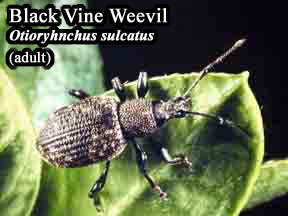Sedum (Sedum)
Plant Health Problems
See Perennials for a detailed discussion of problems that may occur and are common to most herbaceous ornamentals.
Diseases caused by Fungi:
Basal or root rot, Rhizoctonia solani or Fusarium.
Roots and basal stems are rotted, black or brown and collapsed. Sunken lesions may occur at the soil line.
Control with fungicides is not reliably effective and may be prohibitively expensive, so removal of infected plants is important.
Gray mold, flower and leaf blight, Botrytis cinerea.
This fungus occurs everywhere and commonly infects senescing or damaged plant parts such as old flowers, causing a fuzzy gray mold. Spores are produced which are easily blown around. From these tissues the fungus moves into healthy stems and leaves, causing a damaging blight. Disease is favored by cool wet conditions and the presence of overripe fruit or old flower petals.
Sanitation is the most important means of control. Remove dead flowers before gray mold develops. If disease has moved into leaf or stem parts, control may also be achieved with the use of fungicides applied as soon as symptoms are visible. Among the compounds registered for use in Connecticut is thiophanate-methyl. Consult the label for dosage rates and safety precautions.
Leaf spots, Cercospora, Colletotrichum, or Septoria spp.
Leaf spots are very common, typically sharply delimited necrotic areas on plant leaves caused by a wide variety of pathogenic species. Leaf spots usually are favored by wet conditions and may become important if a large number of lesions are present or if they start to coalesce.
Under those conditions, control may also be achieved with the use of fungicides applied as soon as symptoms are visible. Among the compounds registered for use in Connecticut are thiophanate-methyl and sulfur. Consult the label for dosage rates and safety precautions.
Powdery mildew, Erysiphe.
These fungi are obligate plant parasites which grow vegetatively on the plant leaf surface, sending haustoria, structures which absorb food from the host, into epidermal cells. The white mildew seen on the leaf is a combination of vegetative mycelium and spores borne in chains on upright conidiophores. Wind-dispersed mildew spores can germinate without free water under high humidity conditions, and disease is often severe when conditions are humid but dry. Small black over-wintering structures called perithecia are often found in powdery mildew affected areas.
Control may also be achieved with the use of fungicides applied as soon as symptoms are visible. Among the compounds registered for use in Connecticut are potassium bicarbonate, ultra fine oil, sulfur, triadimefon, or thiophanate-methyl fungicides. Consult the label for dosage rates, safety precautions, and directions for use.
Rust, Puccinia.
The term rust refers to both the disease and pathogen causing the disease. Rust fungi are specialized obligate parasites which can cause disease on one (monoecious) or two (heteroecious) host species. Symptoms of rust infection include rust-colored spores or gelatinous horns in powdery pustules on leaves or stems. Surrounding tissue is discolored and yellowed, and plants are often stunted.
Control of heteroecious rusts may be aided by removal of the alternate host, but for most perennials, control may also be achieved with the use of fungicides applied as soon as symptoms are visible. Among the compounds registered for use in Connecticut are sulfur and mancozeb. Consult the label for dosage rates, safety precautions, and directions for use.
Stem rot, Sclerotium rolfsii.
Symptoms include yellowing of lower leaves followed by wilting and death of the rest of the plant. A white cottony mass of mycelium growing around the crown or on the soil near the crown distinguishes this crown rot from others. In this fungus web may be found the whitish to cream color or buff or reddish-brown seed-like sclerotia the size of a pinhead.
Control may include removing and destroying all infected plant parts and removal of top soil around the plant. New soil may replace sclerotia-filled soil.
Insect Problems: Black vine weevil, Otiorhynchus sulcatus.
Black vine weevil, Otiorhynchus sulcatus.
The larvae of this weevil often injure plants in nurseries and ornamental plantings by feeding on the roots. The tops of injured plants first turn yellow, then brown, and the plants may die. The 1/2" long adult weevil is black, with a beaded appearance to the thorax and scattered spots of yellow hairs on the wing covers. Only females are known, and the adults are flightless. They feed nocturnally, notching the margins of the foliage. The legless grub is white with a brown head and is curved like grubs of other weevils. Adults and large larvae overwinter, emerging from May - July. The adults have to feed for 3-4 weeks before being able to lay eggs. Treating the soil with insect pathogenic nematodes can control the larvae, and should be the first line of defense in the landscape. Acephate and fluvalinate are among the compounds registered for control of this pest in Connecticut, and may be applied when there is adult feeding and before they start laying eggs. The usual timing for these foliar sprays is during May, June and July at three week intervals. Insecticide resistance is very common; be aware that adults may appear to be dead following contact with fluvalinate, but may recover from poisoning within a few days. Consult the label for dosage rates and safety precautions.

